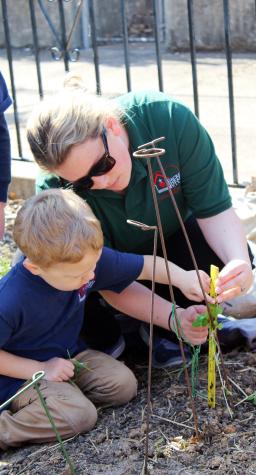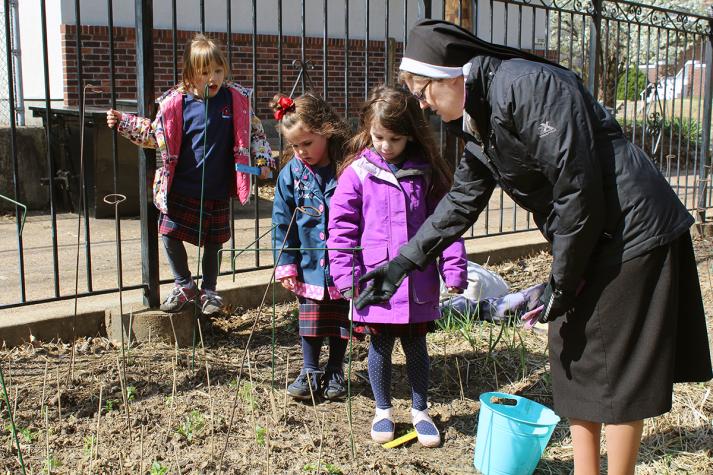ST. LOUIS – A Master Gardener nurtures little minds and mouths at Sacred Heart Villa, a preschool in St. Louis.
University of Missouri Master Gardener Margaret Grant teaches preschool students to grow what they eat and eat what they grow. The program is in its second year.
The school sits in the heart of The Hill, a predominantly Italian neighborhood on high ground south of Forest Park. Grant and MU Extension educational program coordinator Holly Records designed the berm gardens in the schoolyard.
“It was such fun helping the teachers and students come up with themes for several of the gardens,” says Records. There is a Hill garden, dinosaur garden and butterfly garden among the named areas.
The school follows the Reggio Emilia approach, a student-driven educational philosophy that began in post-World War II Italy. The approach focuses on encouraging the child’s natural curiosity and potential in less structured settings. This carries over to the gardens.
“The first time I visited Villa, the students and I just dug around in the soil to see what we could find,” Records said. “Besides worms, grubs and a centipede, we found several very special rocks that were quickly deposited in the treasure pile.”
Early this spring, students planted peas in foam cups. They moved the cups from the classroom to a small greenhouse in the schoolyard. They then transplanted the pea vines to one of more than 20 small berms built by parents and volunteers.
Students learn more than just gardening skills. They research the types plants that will do well in St. Louis’ climate. They also choose which herbs to use in their school lunches. Lettuce, peas, tomatoes, figs, grapes, herbs and pollinators are among the diverse offerings.
Each week, students measure and record the growth of their plants, an activity that develops math skills. They hone science skills by learning plant parts. Students learn to treat their plants like babies in need of nurturing with sun, water and care, says Grant.
She uses gardening as a gateway to teach students to eat healthy and try new foods. “I teach them how to make vegetables taste good,” Grant says. “I want to get them excited about food.”
Records sees the excitement. “Every time I visit Villa with Margaret, a child runs up to her and give her a big hug. ‘Are we gardening or cooking today, Miss Margaret?’”
Grant, a professional chef with a master’s degree in environmental sustainability from Webster University, also prepares food for children as part of the classroom routine. The St. Louis Chef de Cuisine Association funds the cooking-in-the-classroom program.
Recently, she cooked “smashy peas,” one of her grandson’s favorites. She cooked peas and added cream and fresh mint. Most of the children are eager to try new foods. A few are reluctant to experiment, committing only to one pea, but that is how healthy eating begins.
Grant connects the gardening and cooking experiences to the students’ heritage. While serving peas, she asked, “Does your mommy put peas in your tortellini?” She has also served squash-stuffed ravioli and homemade mozzarella. She talks about the food’s color, aroma, texture and taste.
The cooking sessions and gardens give children, parents, teachers and volunteers a sense of school and community pride. Good gardens and good food grow here.
The themed gardens reflect the Italian neighborhood of tidy shotgun-style homes, bakeries and restaurants. Neighborhood residents, including MU Extension Master Gardeners, often volunteer to mentor children about the fig trees that grow in the school garden. Italian immigrants brought the trees to The Hill from Italy after World War II.
Neighbors offer advice on herbs and tomatoes for sauces. A restaurant owner donated garlic bulbs for planting. Grapevines, commonly seen growing in the backyards of Hill homes, provide opportunities for older residents to teach younger ones and share memories.
Students, teachers and administrators hope to offer a small farmers market for local residents and restaurants. Students attending summer camps maintain the gardens during their peak growing time. They also enjoy snacks and lunches made with fruits and vegetables at peak flavor.
Sacred Heart Villa students and teachers share their experiences via Skype with preschool students at St. Joseph’s Catholic School in Imperial, Mo. They have a “friendly competition” to see which garden is blessed with the most produce, says Sister Jude Ruggeri, who grew up in the neighborhood.
“It’s wonderful in lots of ways,” she says. “It teaches the children to take time to view the flowers and plants and enjoy.”
Records says the St. Louis Master Gardener program, including the Villa program, shows urban residents how to grow their own food even with limited space. The classes also bring together a diverse group of people interested in healthy eating. This year’s class of St. Louis Master Gardeners includes three physicians, a concert violinist, a tattoo artist, an oncologist, a stand-up comedian and the owner of a small hardware store.
Learn more about the St. Louis Master Gardner program or visit the Missouri Master Gardener website.
Sidebar:
Tips for gardening with children
Of all the things found growing in a garden, kids are by far the most important, says University of Missouri Extension horticulturist David Trinklein, who offers these tips:
• Let youngsters feel a sense of ownership of their part of the garden space. Label it with their name.
• Kids love digging in the dirt. Let youngsters take part in soil preparation.
• Nothing builds confidence like success. Choose garden plants that are started from seeds and fairly easy to grow. Radishes, carrots and lettuce are good choices.
• Incorporate some “easy” flowers such as zinnia and marigold into the garden plan so kids can pick bouquets to take to their families.
• Kids love to water. Make it a part of their garden chores. Keep an eye out to make sure it is done properly.
• Consider planting theme gardens such as salsa or salad gardens. This will give children a sense of where their food comes from.
• Make the best of time spent with youngsters in the garden by visiting about other things as well. In addition to talking about birds, insects and weeds, talk with children about their friends, school experiences, hopes and dreams.
• Don’t let a lack of space discourage you. Container gardens on a deck or patio can be a learning experience for children also. Grandparents, and parents who share custody, can still garden with little ones through photos on social media. Plant vegetables or flowers at the same time and share notes by telephone or Skype on how your garden is progressing.
Photos available for this release:
Students learn how to make 'smashy peas'
Students at Sacred Heart Villa preschool on The Hill in St. Louis learn how to make 'smashy peas' from chef and Master Gardener Margaret Grant. Photo by Linda Geist.
Students' gardening experience
Students learn math and science as part of their gardening experience. Each week, they measure and record the growth of plants. They research what vegetables to grow in the schoolyard. Photo by Linda Geist.
Preschool students learn gardening skills
Preschool students at Sacred Heart Villa learn gardening skills as part of the school’s Outdoor Classroom program. They grow fruits and vegetables for their school lunches in 23 berms in the schoolyard. Photo by Linda Geist.


